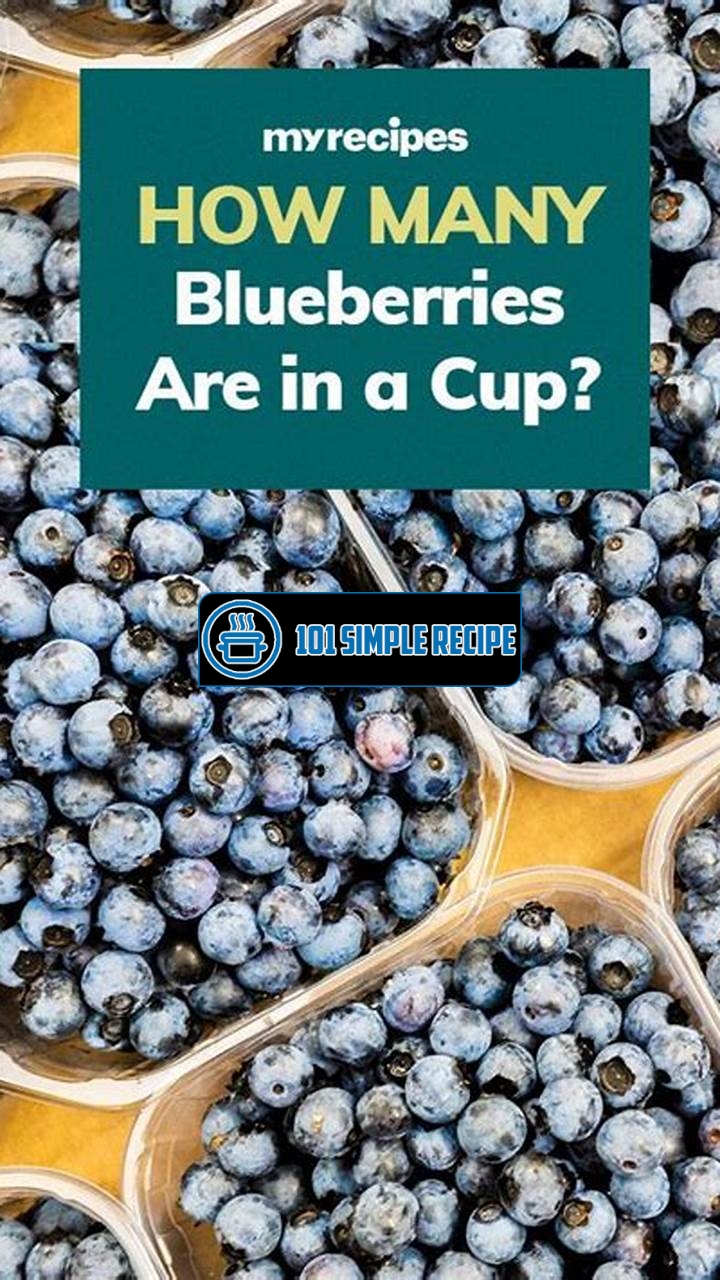Are you tired of guessing the perfect amount of blueberries to use in your favorite recipes? Wondering how many ounces of blueberries you should add to ensure the perfect balance of flavor? Look no further! In this article, we will uncover the ideal blueberry ounce measurement for recipes, so you can achieve culinary perfection every time. Whether you’re making a blueberry pie, smoothie, or muffins, this valuable information will take your blueberry-filled creations to the next level. Get ready to impress your friends and family with your newfound blueberry expertise!

Determining the Quantity of Blueberries in an Ounce
In the world of baking, finding the perfect blueberry ounce measurement for your recipes is essential. Whether you’re whipping up a batch of blueberry muffins or creating a delectable blueberry pie, knowing how many blueberries are in an ounce can make a significant difference in the outcome of your dish. In this article, we will explore the details regarding the number of blueberries you can expect in one ounce.
The Size of Blueberries
Before we dive into the specifics of determining the number of blueberries in an ounce, it’s important to understand the size variations of these delightful berries. Blueberries come in different sizes, ranging from small to large. The size of a blueberry can have a direct impact on the number of berries you will need for a particular recipe.
Small blueberries are typically around the size of a pea, while medium-sized berries are similar to the size of a marble. Large blueberries can be as big as a quarter. Keep in mind that the size of blueberries can vary depending on their variety and freshness, so it’s always a good idea to measure them to ensure accuracy in your recipes.
The Average Weight of Blueberries
Understanding the average weight of blueberries is another crucial factor in determining how many blueberries are in an ounce. While individual blueberries may differ slightly in weight, an average blueberry weighs around 0.02 ounces or approximately 0.57 grams.
By knowing the average weight of a blueberry, you can easily calculate the number of blueberries needed for a recipe that calls for a specific weight. For example, if your recipe requires 2 ounces of blueberries, you would need approximately 100 blueberries to reach that weight.
Calculating the Number of Blueberries in an Ounce
Now that we know the size and average weight of blueberries, let’s delve into how to calculate the number of blueberries in an ounce.
To determine the number of blueberries in an ounce, you can use a simple calculation method. Since an average blueberry weighs around 0.02 ounces, you can divide 1 ounce by 0.02 ounces to find the number of blueberries. This calculation gives us a result of 50 blueberries per ounce.
Therefore, if your recipe calls for 4 ounces of blueberries, you would need approximately 200 blueberries to meet that measurement. It’s important to note that this calculation is based on the average weight of blueberries, so slight variations may occur.
By understanding the size, average weight, and calculation methods, you are now equipped with the knowledge to determine the perfect blueberry ounce measurement for your recipes. Remember, measuring accurately is key to achieving the desired results in your baking endeavors.
Important Note: It is always a good idea to weigh your blueberries to ensure precise measurements in your recipes. The average weight is provided as a guideline, and individual blueberries may weigh slightly more or less.
So the next time you find yourself wondering how many blueberries are in an ounce, remember the tips and calculations shared in this article. Happy baking!
If you’re interested in learning more about weight loss recipes, you might find this weight loss recipe article helpful. It provides tips and ideas for creating healthy and nutritious meals that can support your weight loss goals.
Why Serving Size Matters
Understanding the significance of serving size is crucial when it comes to blueberries. Whether you are baking a pie, making a smoothie, or enjoying them straight out of the container, knowing the proper amount to use can greatly impact the outcome of your recipe or the nutritional value of your snack.
Importance of Accurate Measurement
When following a recipe or trying to maintain a healthy diet, accurate measurement becomes essential. This is especially true when dealing with ingredients that have varying sizes and densities, such as blueberries. Blueberries differ in size, and as a result, their volume can fluctuate. Therefore, relying solely on a visual estimation may lead to inconsistency in your culinary creations or your nutrient intake.
⚖️ Consistency in Flavor and Texture
Using the correct serving size of blueberries ensures that you achieve the desired flavor and texture in your dishes. Adding too few blueberries might result in a bland and lackluster taste, while adding too many can overpower the other ingredients and disrupt the balance of flavors. Additionally, the texture of your recipe can be compromised if the amount of blueberries is not properly measured. Finding the perfect balance is key to achieving a delectable outcome.
Proper Nutrient Intake
Serving size also plays a significant role when it comes to your nutritional needs. Blueberries are packed with essential vitamins, minerals, and antioxidants that offer numerous health benefits. By consuming the recommended serving size, you can enjoy all the nutritional advantages blueberries have to offer while avoiding excessive calorie intake.
The Nutritional Value of Blueberries
Before we delve into the perfect blueberry ounce measurement, let’s take a closer look at the nutritional value of these tiny fruits.
A Nutritional Powerhouse
Blueberries are not only delicious but also incredibly nutritious. They are low in calories, providing only about 85 calories per cup. Despite their small size, blueberries are rich in vitamins C and K, as well as dietary fiber. They also contain potent antioxidants, such as anthocyanins, which have been shown to have numerous health benefits.
Health Benefits
Regular consumption of blueberries has been linked to various health benefits. These include improved brain function, reduced risk of heart disease, enhanced digestion, and better management of blood sugar levels. Additionally, the antioxidants in blueberries help combat oxidative stress and inflammation in the body, contributing to a strengthened immune system.
Recommended Blueberry Serving Size
Now that you understand the significance of serving size and the nutritional value of blueberries, let’s determine the ideal amount to include in your recipes or daily snacks.
A General Guideline
The recommended serving size for blueberries is typically one cup, which weighs approximately 5.3 ounces (150 grams). However, it is essential to note that this measurement may vary depending on the specific recipe or dietary requirements.
⚖️ Adjusting for Recipes
When adjusting the serving size for a particular recipe, consider the overall quantity and balance of ingredients. If the recipe calls for additional fruits or ingredients, you may need to adjust the blueberry measurement accordingly. Remember that personal preference also plays a role in determining the perfect blueberry ounce measurement for your recipe.
Benefits of Consuming One Ounce of Blueberries
Consuming one ounce of blueberries can have several positive impacts on your health. Let’s explore some of the benefits:
Rich Antioxidant Content
Blueberries are known for their high antioxidant content, especially anthocyanins. These antioxidants help protect your cells from damage caused by harmful molecules called free radicals. By consuming one ounce of blueberries, you provide your body with a significant dose of antioxidants, contributing to overall health and well-being.
Improved Cognitive Function
Research has shown that regular consumption of blueberries may improve cognitive function, particularly memory. The antioxidants present in blueberries help stimulate blood flow to the brain, enhancing cognitive performance and reducing the risk of age-related cognitive decline.
Note: This information is not a substitute for professional medical advice. Please consult a healthcare provider to address your specific health concerns.
Enhanced Immune System
Blueberries are loaded with vitamins and minerals that support a robust immune system. Their vitamin C content, in particular, assists in strengthening immune defenses and promoting overall immune function. Including one ounce of blueberries in your daily diet can contribute to keeping illnesses at bay.
Support for Heart Health
Regular consumption of blueberries has been associated with a reduced risk of heart disease. The antioxidants and anthocyanins in blueberries help combat inflammation and oxidative stress, both of which contribute to cardiovascular issues. Including one ounce of blueberries in your diet can be a heart-healthy choice.
Remember, while the recommended serving size is one ounce of blueberries, feel free to adjust it according to your personal preferences and dietary requirements. Enjoy the numerous benefits that these tiny fruits have to offer, and experiment with incorporating them into your favorite recipes!
Other Ways to Measure Blueberries
When it comes to measuring blueberries for recipes, having an accurate measurement is essential to ensure your dish turns out just right. While a kitchen scale is the most precise way to measure ingredients, there are alternative methods available if you don’t have one on hand. In this article, we will explore a few different ways you can measure blueberries without a scale, allowing you to still achieve delicious results.
Using Measuring Cups as a Reference
One method you can use to measure blueberries without a scale is by using measuring cups as a reference. While this method may not provide the same level of precision as a kitchen scale, it can still give you a good estimation.
To use this method, start by filling a measuring cup with blueberries. Be sure to avoid packing them too tightly. Once the cup is filled, take note of the measurement. For example, if you have 1 cup of blueberries, you now have a reference point for future recipes.
Keep in mind that the number of blueberries in a cup can vary depending on their size. Smaller blueberries will naturally allow for more to fit in a cup, while larger berries may take up more space. Adjust your measurement accordingly based on the size of the blueberries you are using.
Counting Blueberries by Volume
If you prefer a more precise method, you can count the number of blueberries by volume. While this may take a bit more time and effort, it can be a helpful way to ensure accuracy in your measurements.
To count blueberries by volume, start by filling a container with blueberries. This could be a bowl, a measuring cup, or any other suitable container. Take note of the volume measurement (in ounces or milliliters) of the container you are using. Then, count the number of blueberries in the container.
Divide the volume measurement by the number of blueberries to get the measurement per individual berry. For example, if you have filled a 10-ounce container and it contains 50 blueberries, each blueberry would be approximately 0.2 ounces.
Alternative Methods for Precision Measurements
While using measuring cups or counting blueberries by volume can be effective for most recipes, there are alternative methods that offer even more precision.
One such method is to use a graduated cylinder, often used in science laboratories. Graduated cylinders are designed to measure liquids but can also be used to measure small solid objects like blueberries. By filling a graduated cylinder with blueberries and taking note of the volume measurement, you can achieve a highly accurate measurement.
Another option is to use a caliper, typically used to measure thickness or diameter. With a caliper, you can measure the diameter of a blueberry and use the measurement to calculate the volume. This method requires a bit more specialized equipment but can provide precise measurements if desired.
In conclusion, while a kitchen scale is the most accurate way to measure blueberries, there are alternative methods available if you don’t have one. Whether using measuring cups as a reference, counting blueberries by volume, or seeking out more precise methods like graduated cylinders or calipers, you can still achieve great results in your recipes. So go ahead and explore these alternatives, and embrace the joy of cooking with the perfect blueberry ounce measurement!
For a refreshing drink option, you can try making this peach lemonade recipe. It combines the natural sweetness of peaches with tangy lemon juice for a flavorful and thirst-quenching beverage.
Buying Blueberries by Weight
When it comes to purchasing blueberries in bulk, buying them by weight is a common practice. This allows you to get the exact quantity required for your recipes or snacks. But how do you decode the quantities and ensure you are getting the perfect ounce measurement for your needs?
Understanding the standard measurement unit for blueberries is essential in this process.
The Standard Measurement Unit for Blueberries
The standard measurement unit for blueberries is an ounce. An ounce is a unit of weight commonly used to measure small quantities of ingredients. In the case of blueberries, it refers to the weight of the fruit without any stems or leaves.
Note: When purchasing blueberries, you should be aware of the standard measurement to ensure you are getting the right amount.
Understanding Packaging Labels
Decoding packaging labels is crucial when buying blueberries by weight. Most packaging labels clearly indicate the weight of the blueberries in ounces. However, it’s important to pay attention to any additional information provided on the label.
Look for labels that specify the weight of the blueberries without stems or leaves to get an accurate measurement.
Some packaging labels may also mention the number of blueberries in each ounce. While this is helpful for estimating quantities, keep in mind that blueberries can vary in size. It’s always best to rely on the weight measurement rather than the number of berries.
Make sure to read the packaging labels thoroughly to gather all the necessary information.
Estimating Quantity for Recipes and Snacks
Estimating the quantity of blueberries needed for recipes or snacks can be a bit challenging. However, with the right knowledge, you can make accurate estimations.
Here are a few tips to help you:
- Refer to your recipes: Check the recipe for specific measurements. It may mention the required quantity of blueberries in ounces or other units of weight.
- Consider your personal preference: If you enjoy a generous amount of blueberries in your dishes, you might want to add a bit more than the suggested quantity.
- Experiment and adjust: If you’re unsure about the quantity, start with a smaller amount, and gradually increase it as you see fit.
- Keep track of your preferences: If you find the perfect quantity of blueberries for your recipes or snacks, make a note of it for future reference.
By following these tips and experimenting with the quantity, you’ll be able to discover the perfect blueberry ounce measurement that suits your taste.
In conclusion, understanding how to purchase blueberries by weight and decode the quantities is essential for achieving the perfect measurement in your recipes and snacks. Pay attention to the standard measurement unit, read packaging labels carefully, and use estimation techniques to find the ideal blueberry ounce measurement. With this knowledge, you’ll be able to enjoy delicious blueberry dishes and snacks with just the right amount of sweetness!
If you’re looking for a recipe that uses blueberries, check out this blueberry tart recipe. It’s a delicious dessert that incorporates fresh blueberries into a flaky pastry crust.
Making the Most of Your Blueberries
Blueberries are a versatile and delicious fruit that can be used in a variety of dishes and beverages to add a burst of flavor and a pop of color. Whether you are looking to expand your culinary skills or simply want to enjoy the natural sweetness of blueberries, there are countless creative ideas to explore. Here are some ways to make the most of your blueberries:
Delicious Blueberry Recipes
When it comes to incorporating blueberries into your cooking and baking, the possibilities are endless. From classic favorites like blueberry muffins and blueberry pancakes to more adventurous options like blueberry salsa and blueberry-glazed salmon, there is a blueberry recipe for everyone. The natural sweetness of blueberries pairs well with both sweet and savory flavors, making them a versatile ingredient in the kitchen.
One popular blueberry recipe is a refreshing blueberry smoothie. Simply blend together fresh blueberries, a banana, Greek yogurt, and a splash of almond milk for a nutritious and delicious treat. You can also add some spinach or kale for an extra boost of vitamins and minerals.
If you have a sweet tooth, try making a blueberry pie or a blueberry crisp. These classic desserts are perfect for showcasing the natural flavor of blueberries. Top them off with a scoop of vanilla ice cream for a truly indulgent treat.
Blueberry Pairings and Combinations
Blueberries can be combined with a wide range of ingredients to create unique and flavorful combinations. Consider pairing blueberries with lemon for a burst of citrusy freshness, or with mint for a refreshing twist. Blueberries also work well with other fruits like strawberries, raspberries, and peaches. These combinations can be used in salads, smoothies, or even as a topping for yogurt or oatmeal.
For a savory option, try adding blueberries to a salad with goat cheese and toasted pecans. The tangy creaminess of the goat cheese and the crunch of the pecans complement the sweetness of the blueberries perfectly.
Preserving Blueberries for Future Use
If you have an abundance of blueberries, you can easily preserve them for future use. One popular method is to freeze them. Simply wash the blueberries, pat them dry, and spread them out on a baking sheet. Place the baking sheet in the freezer for a few hours until the blueberries are frozen, then transfer them to a freezer-safe bag or container.
Another option is to make blueberry jam or jelly. This can be done by cooking the blueberries with sugar and lemon juice until they thicken and reach a spreadable consistency. The finished jam can be stored in sterilized jars and enjoyed throughout the year.
Blueberries can also be dehydrated to make dried blueberries. Simply spread the blueberries out on a baking sheet and place them in the oven on the lowest setting for several hours, or use a food dehydrator if you have one. The dried blueberries can be used in trail mixes, granola bars, or as a snack on their own.
In conclusion, blueberries are a versatile fruit that can be used in a variety of ways to add flavor and flair to your dishes and beverages. From delicious recipes to creative pairings and preserving methods, there is no shortage of ways to enjoy the perfect blueberry ounce measurement for your recipes. So go ahead and get creative with blueberries in your kitchen!
Thank you for taking the time to read our article on how many blueberries are in an ounce. We hope you found the information helpful and insightful. If you have any further questions or if there are any other topics you would like us to cover, please don’t hesitate to reach out. We appreciate your support and we look forward to providing you with more valuable content in the future. Remember, knowledge is power, so keep learning and exploring!
Frequently Asked Questions
Here are some common questions about blueberries and their weight:
| No. | Questions | Answers |
|---|---|---|
| 1. | How many blueberries are in an ounce? | On average, there are about 80 blueberries in one ounce. |
| 2. | Are all blueberries the same size? | No, blueberries can vary in size, but the average size is around 0.4 inches in diameter. |
| 3. | How many calories are in an ounce of blueberries? | There are approximately 16 calories in one ounce of blueberries. |
| 4. | Can I freeze blueberries? | Yes, you can freeze blueberries to extend their shelf life. |
| 5. | How long do blueberries last? | When stored properly in the refrigerator, blueberries can last up to two weeks. |
| 6. | Are blueberries a good source of antioxidants? | Yes, blueberries are packed with antioxidants that can help protect your body against harmful free radicals. |
Closing Thoughts
We hope this article has shed some light on the number of blueberries in an ounce and provided you with valuable information. Remember to always measure your blueberries if you’re following a recipe or tracking your food intake. Blueberries are not only delicious but also nutritious, so enjoy them in moderation and reap the health benefits they offer. Make sure to bookmark our website and visit us again for more informative articles. Have a fruitful day!
Jump to Recipe
How Many Blueberries in an Ounce

Find out how many blueberries are in an ounce and learn about their nutritional value. Discover tips for measuring blueberries accurately and explore delicious blueberry recipes.
- 1 ounce of blueberries
- Take a measuring scale and weigh out one ounce of blueberries.
- Once measured, you can use the blueberries for your desired recipe or enjoy them as a healthy snack.






